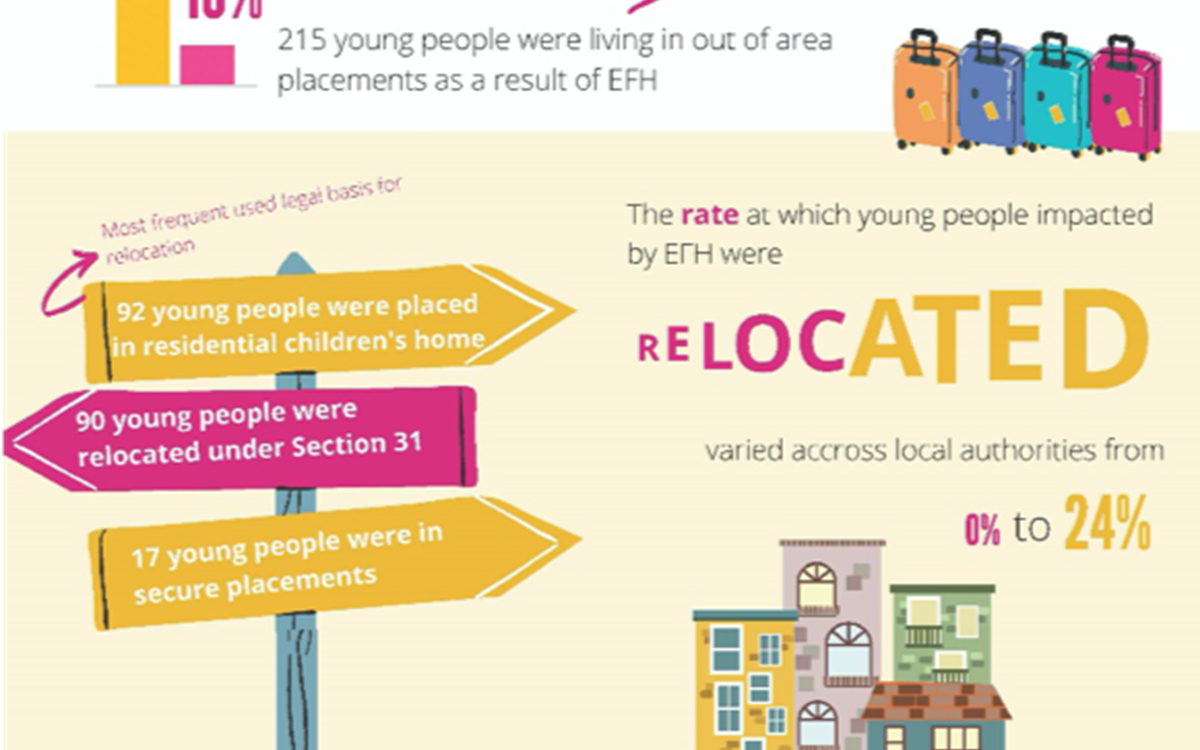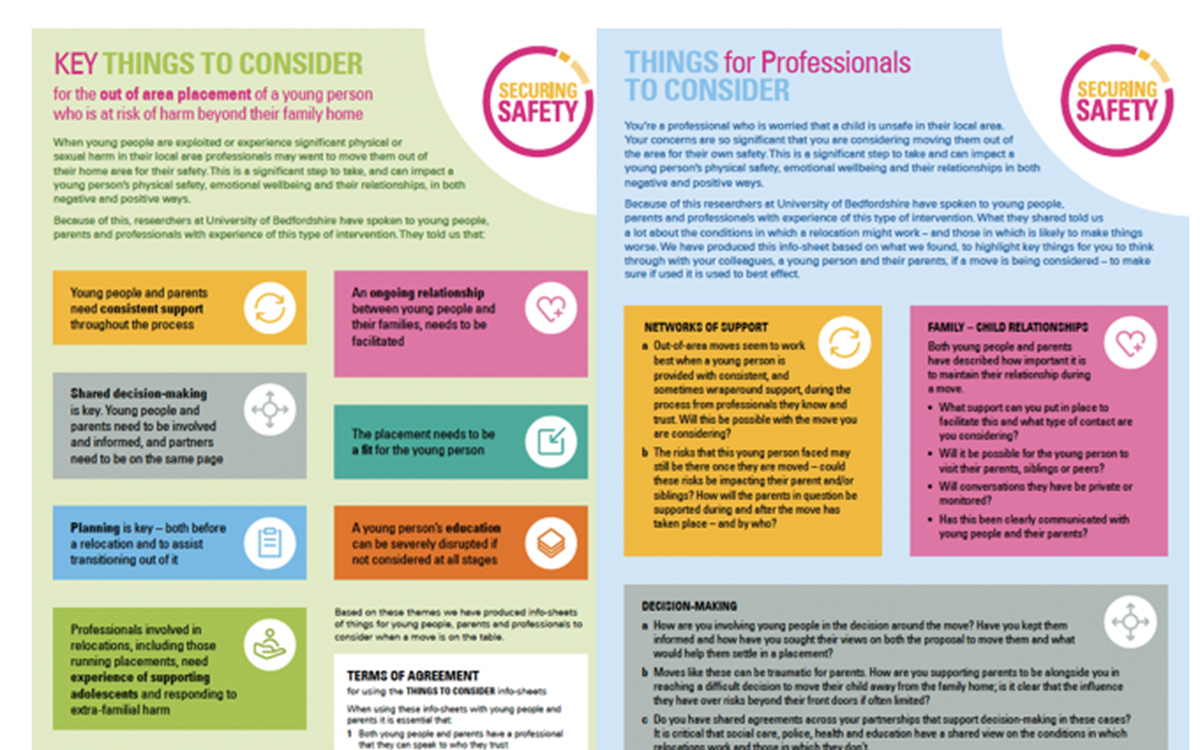Securing Safety – Understanding the use of out of area placements as a response to extra-familial harm in adolescence
Lauren Wroe is a Research Fellow at the Contextual Safeguarding programme at the Safer Young Lives Research Centre, University of Bedfordshire. Lauren was the project lead for the Securing Safety study.
Since early 2019 the Contextual Safeguarding programme has been carrying out research into the use, cost and impact of out of area placements, or ‘relocations’ as a response to extra-familial harm in adolescence. We are now finalising the study, and this blog post will provide a summary of what we found, how we found it, and importantly, what this means for future policy and practice in this area.
As many of our Network members will know, there has been an increased awareness over the past two decades of the types of significant harm adolescents can face beyond their immediate families. In particular, that these forms of harm constitute child abuse and that they require a response from children’s social care in line with children’s legislation and statutory guidance. This has marked the beginning of a shift away from adolescents being positioned as responsible for the harm they experience in their communities, to an understanding rooted in adolescent development theory, that adolescents are often targeted because of the complex physiological and cultural dynamics of their developmental life stage. The Contextual Safeguarding programme has been part of this journey; working with local authorities, academics, children and families and other key stakeholders across the country to develop a framework to support the sector to translate this intention into practice.
Contextual Safeguarding proposes that in order to effectively identify and respond to harm in adolescence, that children’s social care and its partners must look to the contexts in which this harm takes place, contexts that are notably often beyond young people’s families. In doing so, significant harm beyond families becomes a focus of the child welfare system, and service responses are targeted at these places and spaces. That’s why, in 2019, Carlene Firmin began to explore the use of out of area placements as a response to extra-familial harm in adolescence; asking, if young people are being moved away from their families and home towns what does this tell us about the extent to which the sector is able to understand and safeguard young people from harmful contexts? As many in the children’s social care sector contend, as children in care figures continue to rise annually, more needs to be done to support children to remain safely with their families. For these adolescents, whose families are often not a cause of harm, why are they being moved away? And if adolescents have to be moved miles away from their communities to keep them safe, what does this tell us about the sectors ability to create safety in contexts such as schools, neighbourhoods and peer groups?
The Securing Safety study has sought to answer exactly these questions. Funded by the Samworth Foundation we embarked on a participatory, mixed methods research project to approximate the extent to which this type of intervention is used, the rationale for its use and importantly, its actual impact on young people’s experiences of safety. The study has been organised around three phases: a national survey to establish the rates of relocations for adolescents experiencing extra-familial harm; a mixed methods exploration of finance data, focus groups and interviews to establish the time and financial costs associated with relocations, and interviews with young people, parents/carers and professionals to establish the impact of such moves, when viewed holistically; the final phase has focused on dissemination of our findings, including a resource pack for navigating relocations, an infographic, an animation, journal articles (including one published here) and blog posts to summarise and share what we’ve learnt.
Phase One: 1 in 10 young people in out of area placements
You can read the findings of the first phase of the Securing Safety study here in a briefing titled ‘A sigh of relief’ and an accompanying info-graphic (see figure one below) and blog post here. In summary, we surveyed 13 local authority children’s social care teams across England and Wales in September 2019. In that month there were 2,128 young people being supported by children’s social care due to extra-familial risks and 215 (10%) of these young people were being accommodated in out of area placements. This varied significantly across local authorities, with some local authorities relocating no young people, rising to 24% in others. We have published an animation that details these findings here. Through follow-up interviews with children’s social care managers in these local authorities we established that:
- there is little local or national oversight of the rate of out of area placements as a response to extra-familial harm in adolescence. Local authorities had to manually establish these figures.
- there are multiple drivers of the variation seen across local areas, including: strategic decisions to relocate/or not and investment in alternatives; pressure from external agencies (i.e. the police); local availability of placements
- that relocations are often a last resort intervention used to manage escalating physical risks to young people and may have negative consequences for young people’s relationships and mental health

Phase Two: a high cost, high disruption intervention
In the second phase of our study we interviewed 23 young people, parents/carers and professionals, asking them about their experiences of relocations and what impact they have on young people’s physical safety, their relationships and their mental well-being. We partnered with the Young Researchers Advisory Panel at the University of Bedfordshire and a national parent advocacy organisation to design these interview questions; ensuring the approach we took was informed by young people and parents with experience of social care systems.
At the same time our partners at the Rees Centre, Oxford University worked with three of the local authorities from phase one to establish the costs of relocations. Finance data, interviews with staff and focus groups helped to establish the financial, but also the time, implications of planning for, supporting and ending relocations.
Findings from the second phase of our study revealed:
- Relocations can increased physical safety for young people whilst simultaneously damaging relationships, educational attainment and mental health.
- There are certain conditions that support effective relocations that may meet the holistic safety needs of young people; i.e. they may support physical, relational and psychological safety. These include: quality and consistency of support services; suitability of placements; and effective planning; and consideration of alternatives. And particularly emphasised by young people and parents: communication and joint decision making; and supporting family relationships. These are outlined in figure two below.
- Relocations can be high cost interventions that require significant staff time for planning, supporting and ending. There is also substantial variation in costs between local areas, and costs are driven by availability and location of placements.

Phase three: things to consider – policy and practice
We are now working on ensuring the findings from our study inform policy and practice in this area. In the coming months we will be meeting with DfE Ofsted, NAIRO and continuing our conversation with the National Police Chiefs Council to inform a cohesive and considered approach to relocations that are driven by the holistic safety needs of young people. We have also produced a resource pack for young people, parents/carers and professionals to use when a relocation is being considered. You can access this here. Please do share widely.
Main image by Javier Allegue Barros on Unsplash



